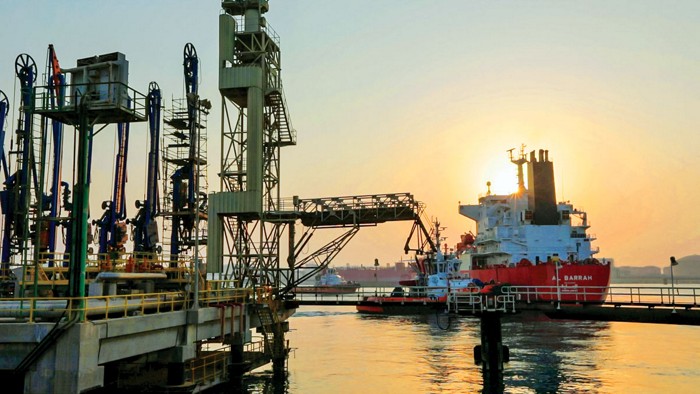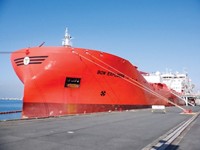Advertisement
Grab your lab coat. Let's get started
Welcome!
Welcome!
Create an account below to get 6 C&EN articles per month, receive newsletters and more - all free.
It seems this is your first time logging in online. Please enter the following information to continue.
As an ACS member you automatically get access to this site. All we need is few more details to create your reading experience.
Not you? Sign in with a different account.
Not you? Sign in with a different account.
ERROR 1
ERROR 1
ERROR 2
ERROR 2
ERROR 2
ERROR 2
ERROR 2
Password and Confirm password must match.
If you have an ACS member number, please enter it here so we can link this account to your membership. (optional)
ERROR 2
ACS values your privacy. By submitting your information, you are gaining access to C&EN and subscribing to our weekly newsletter. We use the information you provide to make your reading experience better, and we will never sell your data to third party members.
Petrochemicals
Will Japan run on ammonia?
Major chemical firms want to build the infrastructure for using ammonia as a fuel
by Katsumori Matsuoka, special to C&EN
April 23, 2022
| A version of this story appeared in
Volume 100, Issue 14

In Japan, Mitsui Chemicals and three other firms are about to demonstrate the feasibility of switching from methane to ammonia as the main fuel for cracking naphtha into petrochemicals. They are not alone. All over Japan, major companies seem to have rediscovered ammonia.
Japan aims to reduce its greenhouse gas emissions to 46% of 2013 levels by 2030. Unlike many sources of energy, ammonia emits no carbon dioxide when burned. The Japanese government sees ammonia as a possible energy solution for a country that is wary of nuclear power and has few local options for renewable power.
The new policy could lead Japan to triple its annual ammonia consumption to 4 million metric tons (t) by 2030 Japan’s Ministry of Economy, Trade, and Industry says. By 2050, when Japan wants to convert all coal-fired power plants to ammonia, consumption could be 30 million t.
“Ammonia could be Japan’s savior when it comes to thermal power generation,” says Nobuyuki Suzuki, general manager of the Basic Chemicals Division at Mitsubishi Gas Chemical (MGC).
Until recently, ammonia did not seem to be a chemical with a bright future. It is a flammable and toxic gas, and in Japan it is regulated by several safety laws.
Still, it’s a staple fertilizer and raw material for chemicals, meaningcompanies in the chemical and shipping industries know how to handle it safely. Enticed by generous Japanese government funding, a few chemical companies have started technical development and demonstration projects, each one worth several hundred million dollars.
Ammonia’s appeal is that it is rich in hydrogen while being easier to transport than hydrogen. But to be a clean energy source, not just any ammonia will do.
Ammonia is made by reacting nitrogen and hydrogen. The nitrogen is drawn from the air, and the hydrogen is typically made by reforming methane, a process that creates CO2. So-called clean ammonia comes in two main varieties: green, produced with hydrogen that is created by splitting water with renewable electricity; and blue, made with traditional hydrogen from which the by-product CO2 is captured and stored underground.
Clean ammonia projects are starting to get off the ground. In 2020, the Saudi firm Sabic worked with Japan’s Institute of Energy Economics to ship 40 t of blue ammonia from Saudi Arabia to Japan as a test of the concept of importing ammonia for power generation. In December 2021, MGC, Ube Industries, Sumitomo Chemical, and Mitsui announced plans to study a comprehensive networkin Japan to secure clean ammonia.
Mitsui and Ube currently produce conventional ammonia in Japan. MGC ceased domestic ammonia production in 2015, when it closed its plant in Niigata, but it continues to make ammonia derivatives at the site. MGC invested in the Indonesian ammonia producer Panca Amara Utama (PAU) in 2016 and started importing ammonia from PAU’s plant when it opened in 2018. Last year, PAU embarked on a study of turning its ammonia blue by capturing CO2 from the plant.
Regardless of their production status, all four members of the study group have over many years accumulated much expertise on the safe production, transport, and use of ammonia. “We have engaged in operation and maintenance of freezing and high-pressure tanks and have sufficient knowledge on operation of specialized ships and buried piping,” Suzuki says.
The group members are joining hands, Suzuki explains, to “pursue economies of scale” in importing, producing, and distributing ammonia in Japan.They also have their sights set on projects overseas, where production of clean ammonia can be cheaper.
“We would like to ensure steady supply of competitive ammonia by 2030,” Suzuki says. To do that, the companies need to build more infrastructure to handle the fuel. “When importing 500,000 t per year of ammonia, for example, we need two terminals at least,” he says. Construction of just the storage tanks for those terminals will cost more than $80 million.
In addition to importing more ammonia, Japanese chemical companies are exploring local production from green hydrogen. Asahi Kasei, for example, wants to make hydrogen by using surplus renewable energy to split water via the alkaline electrolysis process.
In August, Asahi Kasei and the engineering firm JGC Holdings launched a project to demonstrate the use of 10 MW water electrolysis units to make hydrogen for ammonia production. The goal is to duplicate the setup in modular fashion to achieve commercial-scale production, either in Japan or overseas.
The right control system is key to the project. “Since renewable energy is employed, our primary target is to establish a robust system designed to be hardly affected by fluctuations of power generation,” says Mototaka Kai, a sustainability program manager at JGC.
Asahi Kasei has a track record in alkaline water electrolysis technology. The company has been running a 10 MW unit at the Fukushima Hydrogen Energy Research Field, a public-private project in Namie, Japan. It has also taken part in Germany’s Align carbon-capture project and the subsequent Take-Off project, which is aimed at producing aviation fuel from CO2 and hydrogen.

“We have not only electrolytic cells but also all elemental technologies involved in membranes and electrode equipment,” says Nobuko Uetake, manager of Asahi Kasei’s Green Solution Project. She adds that Asahi Kasei intends to use digital technology from Recherche 2000, a Canadian company it acquired in 2020.
In addition to replacing coal in power plants, ammonia could be used instead of methane in furnaces that crack naphtha and other hydrocarbons into petrochemicals. Mitsui’s project to test the feasibility of the approach launched in February with Maruzen Petrochemical, Toyo Engineering, and Sojitz Machinery.
“The technology has a cost advantage when taking into account carbon pricing and the estimated market price for clean ammonia in 2030,” a Mitsui public relations official says.
Ammonia is not a drop-in replacement for methane, however. For example, as a furnace fuel, it burns more slowly than methane, a phenomenon that Sojitz, a designer of burners used in cracking furnaces, will have to take into account. “The four companies can contribute their specialties in R&D,” the Mitsui official says.
The consortium aims to build a 10,000 t per year naphtha-cracking furnace at Mitsui’s complex in Osaka, Japan, and conduct a verification test there. It will later build a larger verification furnace at Maruzen’s facility in Chiba, Japan.
Ultimately, Mitsui would like to see the technology used by ethylene producers across the country. “When fuel for domestic ethylene producers is switched to ammonia, CO2 emissions will be cut by 10.4 million t compared with the present time,” the Mitsui official says.
It is not only well-established Japanese companies that areattracted by ammonia’s potential. Tsubame BHB, a spin-off from Tokyo Institute of Technology, has developed a process to synthesize ammonia at a much lower temperature and pressure than with the traditional Haber-Bosch process. Employing a catalyst devised by Professor Emeritus Hideo Hosono of Tokyo Tech, the process lowers temperature by about 25% and pressure by more than 75%, the company says (Nature 2012, DOI: 10.1038/nchem.1476).
The Haber-Bosch process breaks the triple bond of nitrogen using a catalyst consisting of iron, potassium hydroxide, and alumina. In contrast, the Tsubame process uses an electride, or electronized,catalyst made by placing ruthenium particles on the surface of a cement-like material. The process “increases fluctuations of nitrogen and undoes the triple bonding,” says Toshiharu Yokoyama, Tsubame’s chief technology officer.
The firm plans to test the process in a 20 t per year plant at the Kawasaki factory of Ajinomoto, an amino acid producer and shareholder in the start-up. Tsubame envisions building numerous small ammonia units at plants that make amino acids, fertilizers, and other chemicals. Units could also be set up at semiconductor plants to provide ammonia for depositing nitride films.
“Such equipment will take the place of traditional methods in sectors where local production of ammonia for local consumption has an advantage,” says Tsubame CEO Masahiro Watanabe. The necessary hydrogen can be made from water and local renewable energy.
Tsubame also aims for large-volume production of fuel ammonia through a venture launched in January by the Japanese government and firms including Tokyo Electric Power and the engineering company Chiyoda. The venture seeks to pioneer a new ammonia catalyst that works at milder conditions than the Haber-Bosch catalyst but doesn’t require ruthenium, a precious metal.
The road to turning ammonia into a fuel that runs Japan will be long and difficult. But MGC’s Suzuki is encouraged that multiple companies and the government are joining to try to make it happen. “No one knows the whole picture of ammonia,” he says. “It is time to discuss and act on the Japanese ammonia industry from a larger perspective.”
Katsumori Matsuoka is a freelance writer based in Japan.






Join the conversation
Contact the reporter
Submit a Letter to the Editor for publication
Engage with us on Twitter